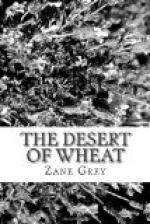“A crop may become infected with smut in a number of different ways. Smut was originally introduced with the seed, and many farmers are still planting it every season with their seed wheat. Wheat taken from a smutty crop will have countless numbers of loose spores adhering to the grains, also a certain number of unbroken smut balls. These are always a source of danger, even when the seed is treated with fungicides before sowing.
“There are also chances for the infection of a crop if absolutely smut-free seed is employed. First, soil infection from a previous smutty crop; second, soil infection from wind-blown spores. Experiments have shown that separated spores from crushed smut balls lose their effective power in from two to three months, provided the soil is moist and loose, and in no case do they survive a winter.
“It does not seem probable that wheat smut will be controlled by any single practice, but rather by the combined use of various methods: crop rotation; the use of clean seed; seed treatment with fungicides; cultural practices and breeding; and selection of varieties.
“Failure to practise crop rotation is undoubtedly one of the main explanations for the general prevalence of smut in the wheat-fields of eastern Washington. Even with an intervening summer fallow, the smut from a previous crop may be a source of infection. Experience shows that a fall stubble crop is less liable to smut infection than a crop following summer fallow. The apparent explanation for this condition is the fact that the summer fallow becomes infected with wind-blown spores, while in a stubble crop the wind-blown spores, as well as those originating from the previous crop, are buried in plowing.
“If clean seed or properly treated seed had been used by all farmers we should never have had a smut problem. High per cents. of smut indicate either soil infection or imperfect treatment. The principle of the chemical treatment is to use a poison which will kill the superficial spores of the smut and not materially injure the germinating power of the seed. The hot-water treatment is only recommended when one of the chemical ‘steeps’ is not effective.
“Certain cultural practices are beneficial in reducing the amount of smut in all cases, while the value of others depends to some extent upon the source of the smut spores. The factors which always influence the amount of smut are the temperature of the soil during the germinating period, the amount of soil moisture, and the depth of seeding. Where seed-borne spores are the only sources of infection, attention to the three factors mentioned will give the only cultural practices for reducing the amount of smut.
“Early seeding has been practised by various farmers, and they report a marked reduction in smut.
“The replowing of the summer fallow after the first fall rains is generally effective in reducing the amount of smut.




